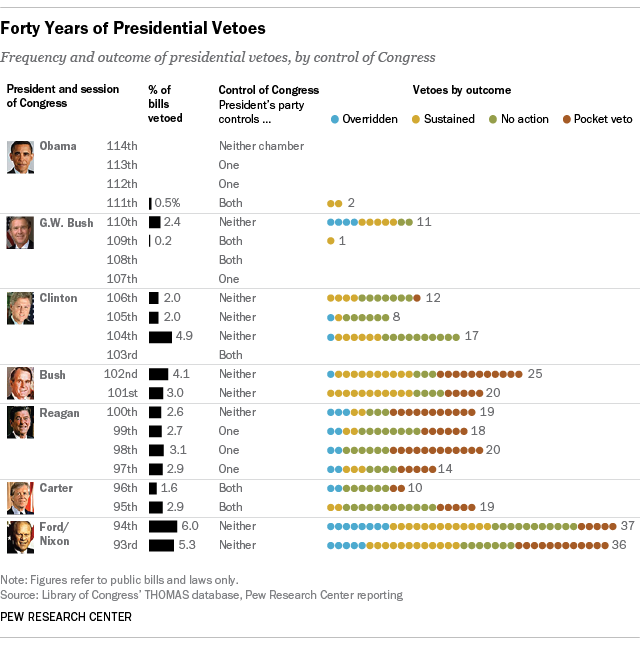 For the first time in his presidency, Barack Obama now must deal with a Congress completely controlled by Republicans. That’s led some political observers to predict that Obama will be using his veto pen a lot more in his last two years in office than he did in the first six. (The White House already has threatened to veto bills authorizing the controversial Keystone XL pipeline, changing the Affordable Care Act’s definition of a full-time worker, and delaying certain provisions of the Dodd-Frank financial-reform law.)
For the first time in his presidency, Barack Obama now must deal with a Congress completely controlled by Republicans. That’s led some political observers to predict that Obama will be using his veto pen a lot more in his last two years in office than he did in the first six. (The White House already has threatened to veto bills authorizing the controversial Keystone XL pipeline, changing the Affordable Care Act’s definition of a full-time worker, and delaying certain provisions of the Dodd-Frank financial-reform law.)
A look at recent history indicates that presidents do, in fact, veto more bills when both houses of Congress are controlled by the opposing party. We examined more than four decades of legislative data, courtesy of the Library of Congress’ THOMAS website, and found that when presidents are of one party and Congress is controlled by the other, they vetoed 3.6% of all public bills presented to them, versus just 1% when both House and Senate were controlled by the president’s party. When control of Congress was divided, presidents vetoed 1.9% of the public bills that reached their desks. (Public bills are those of general applicability, and account for the overwhelming number of laws Congress makes.)
This makes intuitive sense. Presidents have more leverage with Congress to shape legislation to their liking when their party controls one or both chambers, and congressional leaders usually try to avoid showdowns with presidents of their own party. Conversely, a Congress run by the opposition may deliberately seek out confrontation — sending bills to the White House that are sure to get vetoed so as to sharpen political contrasts with the president.
Vetoes come in two varieties. With regular vetoes, the president refuses to sign a bill and instead sends it back to Congress with his written objections; if two-thirds of each chamber vote to re-pass the bill, the veto is overridden and the measure becomes law. “Pocket vetoes” occur when Congress has adjourned and can’t officially receive the vetoed measure; in such cases the president can kill the bill by simply doing nothing. (Whether and under what circumstances presidents can pocket-veto bills during mid-session adjournments and recesses has long been a sore spot between the two branches; court rulings have been ambiguous.)
By our count, presidents have issued 194 regular vetoes and pocket-vetoed another 75 bills between 1973 and 2014. Of these, 140 regular vetoes (72% of the total) and 45 pocket vetoes (60% of the total) occurred when both houses of Congress were controlled by the opposition party — a total of 18 years out of the total 42-year period studied (that is, 43% of the time.)

By their nature, pocket vetoes can’t be overridden, since Congress isn’t in place to act. And while Congress can try to override a regular presidential veto, it doesn’t often succeed: Only 31 of the 194 vetoes referred to above (16%) were overridden. Override attempts failed in 74 cases (38%), and in the remaining 89 cases (46%) Congress accepted the vetoes with no attempt to override. Put another way: If the President vetoes a bill it has a better than 8-in-10 chance of staying vetoed.
The chances of a successful override improve when one or both houses of Congress are controlled by the party in opposition to the president’s. According to our analysis, of the 29 regular vetoes issued when either the House or the Senate (but not both) was run by the opposition, six (20.7%) were overridden. Twenty-three of the 140 vetoes issued when both chambers were controlled by the opposition (16.4%) were overridden. By contrast, only two of the 25 vetoes issued during the dozen years when the same party controlled the House, Senate and the White House were overridden.
George W. Bush’s presidency may hold some clues to what lies ahead for Obama. Bush vetoed no bills in his first term and only one (which was sustained) in his second. (Democrats controlled the Senate for most of Bush’s first two years in office; otherwise the GOP dominated Capitol Hill.) In 2006, however, Democrats won control of both the House and Senate. During the subsequent 110th Congress Bush issued 11 vetoes, four of which were overridden.
To date, Obama has vetoed just two bills — both, as it happens, during the two years Democrats controlled both the House and Senate. The first, a stopgap budget resolution, was vetoed in December 2009 as “unnecessary” given the subsequent passage of a regular defense-spending bill. The other veto, in October 2010, was of a bill concerning the interstate recognition of notarizations by federal and state judges — which doesn’t sound like much, except that it came as several major banks were entangled in the “robo-signing” foreclosure scandal. In his disapproval memorandum, Obama said he was concerned about the measure’s “possible unintended impact…on consumer protections, including those for mortgages.” Both vetoes were sustained.



